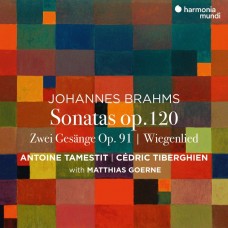|
中提琴美聲世界第二集
布拉姆斯: 中提琴奏鳴曲作品120, 第一,二號 / 夜鶯 作品97 / 搖籃曲 / 2首歌曲集
塔梅斯提 中提琴
提貝岡 鋼琴
馬提亞斯.葛納 男中音
圓滿地完成十九世紀中最傑出的大量室內樂中的一件作品 - 布拉姆斯的兩首奏鳴曲作品120需要精湛的技巧並完全專注於這兩首特別抒情的曲目. 正如同在著名的(搖籃曲)中, 旋律線以幾乎是活生生自然的方式展開, 非常接近於人類的聲音. 因此在這樣的前提下, 毫不訝異的會發現在兩首藝術歌曲中的男中音和中提琴是對等的, 在此被三位優秀的音樂家所詮釋.
Magisterially rounding off one of the nineteenth century's most remarkable bodies of chamber music, Brahms's two Sonatas op.120 call for a virtuosity wholly dedicated to their extraordinary lyricism. Just as in the famous 'Lullaby', the melodic line develops with an almost organic naturalness, in close proximity to the human voice. Hence it is hardly surprising in this context to discover two lieder in which baritone and
viola are treated as equals, and which are here interpreted by three exceptional musicians!
JOHANNES BRAHMS (1833-1897)
Viola Sonata no. 1 op. 120 no. 1
F minor / fa mineur / f-Moll
1. I. Allegro appassionato 3'41
2. II. Andante un poco adagio 4'38
3. III. Allegretto grazioso 4'19
4. IV. Vivace 5'01
Nachtigall op. 97 no. 1 [arr. for viola and piano]
5. Langsam 2'27
Viola Sonata no. 2 op. 120 no. 2
E-flat major / Mi bemol majeur / Es-Dur
6. I. Allegro amabile 8'37
7. II. Allegro appassionato 4'53
8. III. Andante con moto - Allegro 6'58
Wiegenlied op. 49 no. 4 [arr. for viola and piano]
9. Zart bewegt 1'33
Zwei Gesange for Voice, Viola and Piano op. 91
10. 1. Gestillte Sehnsucht (Friedrich Ruckert) 5'08
11. 2. Geistliches Wiegenlied (Emanuel Geibel, after Lope de Vega) 5'07
Antoine Tamestit, Stradivarius viola
Cedric Tiberghien, Bechstein piano
Matthias Goerne, baritone (10-11) |
|



